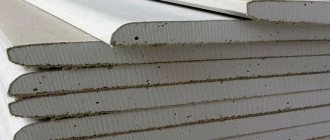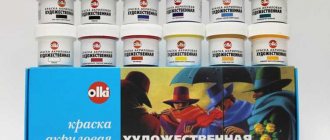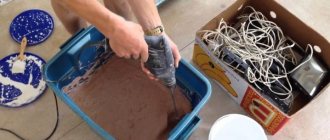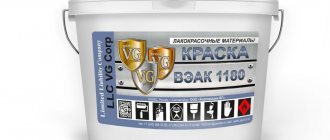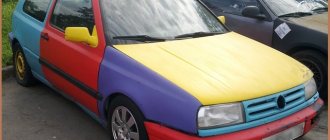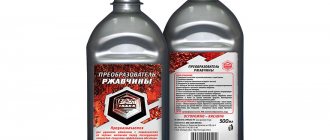Viscosity of paints and varnishes
To better understand how to obtain the desired viscosity, it is necessary to understand the factors that influence this level. The viscosity of paints and varnishes can change under the influence of the following factors:
- Chemical elements used in the composition;
- The amount of solvent introduced into the composition;
- Temperature indicators of the air, the base and the paint and varnish material itself.
The ability of paint to withstand flow largely depends on temperature indicators. When heating occurs to +60-70 degrees, the parameter decreases greatly; an increase in degrees has a slight effect on the material. In order to measure the indicator correctly, the process is carried out under certain conditions.
To improve viscosity, thinners are added. But it is important to administer the product in the correct quantity, otherwise it may disrupt the properties of the composition and lead to complete damage.
To improve viscosity, thinners are added.
Preparation of acrylic, base enamel and varnish
When preparing acrylic enamels and varnishes, it is important to remember that these materials are two-component (2K), which means that their curing, unlike one-component materials (1K), which dry under the influence of natural processes in the environment, occurs according to a completely different pattern - due to reaction with a hardener (polyisocyanate) - a substance for cross-linking molecules. The acrylic binder enters into a chemical reaction with the hardener, as a result of which many small molecules combine into one macromolecule - a polymer
Thinner is added to two-component materials only to achieve the required viscosity.
Polymerization of one-component alkyd enamel due to oxidation of the alkyd binder as a result of reaction with oxygen
Polymerization of two-component acrylic enamel due to the reaction between the acrylic binder and the hardener.
What am I talking about? The fact is that the material to which we add more hardener than required will never gain optimal hardness under any conditions, since the number of molecules for cross-linking exceeds the number of molecules of the acrylic binder itself. The molecular chains will not be stitched together correctly and you will have to say goodbye to hardness, and therefore gloss, forever.
Therefore, you should strictly follow the proportions of adding hardener, which are indicated by the manufacturer on the can or in the technical manual. For example, the mixing ratio with hardener is indicated as 2:1. This means that you need to mix two parts paint and one part hardener. We are talking about volume, not grams or milliliters.
The mixed components must correspond to each other in fullness. This, I think, is understandable. For example, if you take a highly filled HS varnish, you need to understand that the concentration of polymer in it is so high that the molecules actually “crack” in the jar. And if you mix it with a low-fill LS hardener, then there simply won’t be enough crosslinking material for correct crosslinking. The same thing will happen if you mix LS varnish and HS hardener. The number of cross-linking molecules is greater, which means there is nothing to hope for correct polymerization.
Let me remind you once again that:
- in one-component
materials (alkyds, base enamels, 1K primers), only a thinner is added; - In two-component
materials (acrylic enamels and varnishes, 2K primers), a hardener is first added, then the mixture is brought to the desired viscosity with a thinner. There may be exceptions - this applies to “superfilled” UHS/VHS materials. No diluent may be added to them at all.
As for the proportions, they are different in different systems, but usually up to 50% hardener and 10-20% thinner are added to two-component products. 50-60% thinner is usually added to base enamels.
I repeat once again - this is approximately. With all the variety of types of enamels and varnishes, it is impossible to give one recipe for all occasions by definition. Therefore, you should always act in accordance with the manufacturer's recommendations. The proportions indicated in the technical documentation or on the can were determined through repeated laboratory tests, and therefore they must be observed.
You also need to remember that the thinner used must be linked to the temperature at which painting work is carried out.
What depends on viscosity
Why even measure the viscosity level, which depends on the indicator? The influence of the parameter on the tool that will need to apply paint to the surface is highlighted. Whether you use a roller, brushes or a spray gun largely depends on the quality of the paint. Also, the influence of the parameter is significant in the points described below:
- An excessively viscous composition is difficult to distribute over the surface; this will make the layer thicker, and the strength of the result will suffer. The drying of the layer will also slow down;
- A thick consistency will not be able to cover all small flaws, absorb deeper into the base, this will lead to a deterioration in the level of adhesion;
- A thick layer leads to smudges and an unsightly finish;
- Inexpensive spray bottles cannot distribute thick formulations.
The wrong consistency of paint for a spray gun can lead to the need to disassemble it and completely clean it; the remaining part will simply disappear. A composition that is too liquid will not be able to paint the surface efficiently, more layers will have to be made, consumption and work time will increase, and more effort will have to be made.
An excessively viscous composition is difficult to distribute over the surface; this will make the layer thicker, and the strength of the result will suffer.
Selecting a spray gun
Before purchasing a tool, you need to understand what kind of work and in what volumes you will perform with its help. The viscosity of the dyes is also important: some models are designed to work only with certain types of materials. For example, a mechanical spray gun is worth purchasing if you are going to spray liquids with low viscosity. To use the spray gun in the field, buy a battery-powered model. But large-scale work with high quality painting is easier to do with a pneumatic tool.
Technology type
HP – spray paint at high pressure. The devices are characterized by their low price and high material consumption: losses amount to up to 65%. After painting, the surface needs additional sanding and polishing.
HVLP - spray materials at low pressure and a large volume of air. The quality of painting will be much higher than that of paint sprayers using HP technology, and material losses will be no more than 35%.
LVLP - spray paint at low pressure and low air flow. Such devices transfer about 70% of the coloring materials to the surface, and the coating is as smooth and uniform as possible. Spray guns using LVLP technology have the highest cost.
The functionality of painting tools largely depends on the technology of work. Thus, HP is not intended for working with enamels and varnishes, HVLP sprays most materials, and LVLP is suitable for all types of paint and varnish coatings, as well as liquid and dry mixtures. Spray guns using AllPaint technology can spray any composition.
Power
The quality of the coating and the speed of work depend on the power of the electric spray gun. Devices with a rating of up to 600 W require a highly qualified technician, since in inept hands they will leave stains. Spray guns consuming 600 watts or more are more expensive, but their speed and quality of coverage will be much higher.
In pneumatic designs, the power of the compressor is indicated. In most models it is 1100-1800 W. This will be quite enough for painting walls and ceilings, but industrial scale work requires more powerful devices.
Pressure
Can range from 0.6 to 10 or more bar:
- a minimum pressure of 0.6 bar is optimal for precise work with low paint consumption;
- a reading of 4-5 bar is suitable for applying most materials;
- a pressure of 6 bar or more is required to spray liquid primer, however, at such rates, material losses can reach 40%.
Typically, compressors compress air to 8 bar. After this, they automatically turn off, and when the pressure drops to 5-6 bar, the device turns on and pumps the required volume of air into the receiver. Expensive models of spray guns pump pressure up to 10 bar and higher.
Performance
This parameter shows how much compressed air the device produces in 1 minute. Different technologies require different indicators: for example, HVLP spray guns require from 180 l/min. If you choose a less efficient compressor for them, the pressure will quickly drop, which will negatively affect the quality of the paint. As a rule, the documentation indicates the amount of intake air. However, during compression, up to 35% of its volume is lost, so to better calculate this indicator, you need to multiply the declared parameter by 0.65.
The technical parameters indicate the performance of not only the compressor, but also the spray gun itself. In most models it is 0.1-2 l/min - this is exactly the amount of paint that passes through the gun nozzle per unit of time. High rates are appropriate for processing large areas, and low rates are appropriate for precise, neat work. The more power a device has, the higher its performance, speed, and price will be.
Dimensions and materials
Spray guns can differ radically in weight and volume: from compact budget models weighing 1.2-2 kg to heavy structures weighing more than 50 kg with 50 liter receivers.
As for the volume of the paint tank, it ranges from 0.1 to 2 liters. A larger capacity increases the weight of the device, but extends the operating time. The paint tank can be located either at the top or at the bottom of the spray gun. Top-mounted containers are made of transparent plastic or nylon, and their volume usually does not exceed 1 liter. The tanks, which are located at the bottom of the device, are more spacious and are often made of metal. The price of the device is practically not affected by the volume and material of the paint tank.
When purchasing a spray gun, pay attention to the length of the hose, if it is included in the package: it can range from 1.2 to 5 or more meters. A long hose makes the device more mobile, however, in some models the paint can only be supplied over a certain distance, check this before purchasing.
How to measure viscosity
Viscosity determination by Russian manufacturers is carried out in seconds. And foreign brands use the din unit. There is a din table for paint viscosity, which helps to check what level should be for different compositions - acrylic, water-based and others.
Time is recorded and how quickly the paint passes through a special hole is assessed. The faster this happens, the more liquid the composition.
There is a din table for paint viscosity, which helps to check what level different compositions should have.
Measurement Features
The difference in the name of the unit in different countries does not in any way affect the operation of a special device called a viscometer. The parameter is measured over time, the process of flow of the composition takes seconds. And accordingly, the faster it flows through a hole of a certain size, the more liquid the consistency.
The parameter is measured over time, the process of flow of the composition takes seconds.
Methods for determining viscosity
As a standard, a special device is used for measurements, which was mentioned earlier, a viscometer. But if it is not available, then the folk method of visual assessment can be used; it does not give the same exact result, but can be quite acceptable.
If a viscometer is not available, then the traditional method of visual assessment can be used.
Determination of viscosity with a viscometer
To use the device, you should learn the rules of how to use a paint viscometer. The process is simple and includes the following steps:
- Water is poured into a special bathtub and equipment, it helps maintain the required temperature at +20 degrees;
- The nozzle on the viscometer closes;
- A special compartment for paint and varnish material is filled with the selected paint up to the point of the hooks;
- It is necessary to install the equipment correctly, for this purpose there are screws on it that allow you to adjust the position, the sharp parts of the hooks must be placed in a barely noticeable position and be on the same plane;
- The compartment with paint is closed, a thermometer is inserted into a special hole, the nozzle is not opened yet, and it is placed near the beaker;
- When the paint and varnish material reaches the desired temperature of +20 degrees, and bubbles appear, the nozzle can be opened and the seconds can begin to be counted; the count ends after the composition has been added to the container at the level of 50.
If work will be carried out with thick types of materials, then a ball type viscometer is used. Its measurement principle involves counting the seconds the balls pass vertically.
If work will be carried out with thick types of materials, then a ball type viscometer is used.
“Folk method” of measuring viscosity (“by eye”)
This technique depends on the experience of the master; professionals can visually understand how well the paint will be distributed over the surface. The paint is stirred using a stick made of wood or metal. Then take out the stick to see how quickly the composition will drain. And evaluate the degree of density.
Craftsmen made a viscometer for paint with their own hands; to do this, you just need to take a syringe and cut it to a size of 10 mm, and also cut off half of the lower end. The product is poured and the drainage time is recorded.
Take out the stick to see how quickly the composition will drain.
Types of solvents
To properly dilute paint for a spray gun for painting a car, you need to consider:
- proportions;
- type of solvent.
It is advisable to use products from the same manufacturer. This approach will avoid incompatibility and other problems associated with obtaining the desired viscosity. But if this is not possible, refer to the dilution instructions and enamel parameters.
By evaporation rate
The classification includes 3 types:
- slow - used in summer and hot weather;
- universal - average evaporation rate, optimal for painting in the off-season;
- fast - preferable for paint and varnish work in winter.
The degree of volatility is the main characteristic of a solvent. It determines how long it will take for the substance to evaporate from the painted surface.
According to physical and chemical indicators
Based on their origin, there are 2 solvents:
- Organic - solvent, gasoline, kerosene, turpentine and alcohol. Highly flammable substances with a persistent unpleasant odor. Dissolves oil paints and acrylic-based compositions.
- Inorganic - water, salts, ammonia, amine and phosphorus solutions. Highly specialized, which made them a less popular option.
Solvent
According to their physicochemical properties, natural solvents are divided into light, medium and solid volatile.
Equipment for viscous materials
If the material has a viscous property, then it is usually applied using spray guns. Different types of spray guns are suitable for this purpose. The following options can be distinguished:
- Airless type, in which the pump immediately pushes out the paint without using air. Its efficiency in using paint is high, but the price is also high, so it is often chosen by professionals;
- Pneumatic, which works by creating pressure with air. More affordable type.
If the material has a viscous property, then it is usually applied using spray guns.
A special case
Two-component dyes stand apart - acrylic with organic solvents, epoxy, polyurethane and some others.
How to dilute these materials to working viscosity?
- First, the paint is mixed with a hardener. Of course, strictly in the proportion specified by the manufacturer: both a lack and an excess of hardener will adversely affect the strength of the coating.
- Then the viscosity of the resulting dye is checked with a viscometer and, if necessary, diluted to a working consistency.
How to measure the required amount of base and hardener?
- If the volume is small, this can be done using measuring cups.
- In large cylindrical containers it is easier to use a measuring ruler. If the height of the paint level without hardener is 40 centimeters, then to obtain a ratio of 1:4 it is enough to add it to a level of 50 cm.
Do not forget: this method will give an accurate result only in a cylindrical container. An ordinary bucket has the shape of a truncated cone, which will distort the proportions.
Two-component dyes are diluted after adding a hardener.
Viscosity of water-based paint
The viscosity of water-based paint, if we take into account the Russian unit, should be on average a minimum of 40, maximum of 45 seconds when manual application methods are used. For a spray bottle, the indicator will be different: 20-25 seconds. The viscosity of water-based paint in din has approximately the same values, only the designation changes.
The viscosity of water-based paint should be on average a minimum of 40, maximum of 45 seconds.
What values are considered optimal?
Each manufacturer can indicate its own viscosity parameter that will be needed. This value may be written on the product label. Or you can find it on the company’s website. There is a single table with average indicators, it will also help in this matter.
Each manufacturer can indicate its own viscosity parameter that will be needed.
If the paint is diluted to the desired viscosity, it will be easier to obtain a high-quality result. Determining its value is easy and the process does not take much time. It is especially important to consider viscosity when working with a spray gun.

